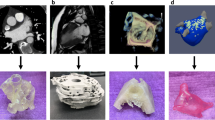Abstract
Purpose of Review
Although simulation was adopted many years ago to complement training programs, more recently it has become an integral part of planning individual invasive procedures as well as understanding and developing new devices and techniques. Here, we review the different types of simulation and modeling and their impact on the field of interventional cardiology.
Recent Findings
Three-dimensional model printing has been employed to strategize complex structural procedures for various congenital heart defects and valvular heart diseases. Ex vivo bench testing permitted understanding the relationship of new technologies with neighboring structures and enabled the refinement of the devices and procedural steps themselves. In vitro simulation and computational analyzes have enhanced our understanding of flow dynamics in bifurcation diseases, transcatheter therapies, congenital defects, and predicting outcomes for transcatheter valve technologies and techniques.
Summary
Incorporating simulation, bench testing, computational analyzes, and three-dimensional modeling will enable the field of interventional cardiology to expand while optimizing techniques and maintaining best practices.




Similar content being viewed by others
References
Papers of particular interest, published recently, have been highlighted as: • Of importance •• Of major importance
• Vukicevic M, Mosadegh B, Min JK, Little SH. Cardiac 3D printing and its future directions. JACC Cardiovasc Imaging. 2017 Feb;10(2):171-184. doi: 10.1016/j.jcmg.2016.12.001. PMID: 28183437; PMCID: PMC5664227. Provides a thorough summary of the 3D Printing technology.
•• Harb SC, Rodriguez LL, Vukicevic M, Kapadia SR, Little SH. Three-Dimensional Printing Applications in Percutaneous Structural Heart Interventions. Circ Cardiovasc Imaging. 2019 Oct;12(10):e009014. doi: 10.1161/CIRCIMAGING.119.009014. Epub 2019 Oct 9. Provides an overview of the clinical utilities of 3D printed models.
Alasnag M, Sweidan R, Nosir Y, Bokhari F, Al-Shaibi K. 3-Dimensional modeling to plan tricuspid valve in valve in a patient with a permanent dual-chamber pacemaker. HeartRhythm Case Rep. 2020 Jun 5;6(9):588-590. doi: 10.1016/j.hrcr.2020.05.021. PMID: 32983872; PMCID: PMC7498512.
Alasnag M, Al-Nasser I, Poqueddu M, Ahmed W, Al-Shaibi K. 3D model guiding transcatheter aortic valve replacement in a patient with aortic coarctation. JACC Case Rep. 2020;2:352–7.
Farooqi KM, Saeed O, Zaidi A, Sanz J, Nielsen JC, Hsu DT, et al. 3D printing to guide ventricular assist device placement in adults with congenital heart disease and heart failure. JACC Heart Fail. 2016 Apr;4(4):301–11. https://doi.org/10.1016/j.jchf.2016.01.012.
Wang DD, Eng M, Kupsky D, Myers E, Forbes M, Rahman M, et al. Application of 3-Dimensional Computed Tomographic Image Guidance to WATCHMAN Implantation and Impact on Early Operator Learning Curve: Single-Center Experience. JACC Cardiovasc Interv. 2016 Nov 28;9(22):2329–40. https://doi.org/10.1016/j.jcin.2016.07.038.
Ooms JF, Wang DD, Rajani R, Redwood S, Little SH, Chuang ML, Popma JJ, Dahle G, Pfeiffer M, Kanda B, Minet M, Hirsch A, Budde RP, De Jaegere PP, Prendergast B, O'Neill W, Van Mieghem NM. Computed Tomography-Derived 3D Modeling to Guide Sizing and Planning of Transcatheter Mitral Valve Interventions. JACC Cardiovasc Imaging. 2021 Mar 11:S1936-878X(21)00146-7. doi: 10.1016/j.jcmg.2020.12.034. Epub ahead of print.
Wang DD, Qian Z, Vukicevic M, Engelhardt S, Kheradvar A, Zhang C, et al. 3D Printing, Computational Modeling, and Artificial Intelligence for Structural Heart Disease. JACC Cardiovasc Imaging. 2021 Jan;14(1):41–60. https://doi.org/10.1016/j.jcmg.2019.12.022 Epub 2020 Aug 26.
• Chatzizisis YS. Complex cardiovascular interventions: visualization, planning, outcomes. JACC Case Reports 2019;1:124-6. Provides an example of the first cases when simulation was used to assist in cases.
•• Antoniadis AP, Mortier P, Kassab G, Dubini G, Foin N, Murasato Y, et al. Biomechanical Modeling to Improve Coronary Artery Bifurcation Stenting: Expert Review Document on Techniques and Clinical Implementation. JACC Cardiovasc Interv. 2015 Aug 24;8(10):1281–96. https://doi.org/10.1016/j.jcin.2015.06.015Provides descriptive explanation of modeling for bifurcation stenting. Provides an overview of the utility of bench testing in bifurcation stenting.
•• Iles TL, Burzotta F, Lassen JF, Iaizzo PA. Stepwise visualisation of a provisional bifurcation stenting procedure - multimodal visualisation within a reanimated human heart utilising Visible Heart methodologies. EuroIntervention. 2020;16:e734–7 This is the main article describing the Visible Heart technology adopted by the consensus European Bifurcation Club document and used to train early career individuals.
•• Burzotta F, Lassen JF, Lefèvre T, Banning AP, Chatzizisis YS, Johnson TW, et al. Percutaneous coronary intervention for bifurcation coronary lesions: the 15th consensus document from the European Bifurcation Club. EuroIntervention. 2021;16(16):1307–17. https://doi.org/10.4244/EIJ-D-20-00169This is the latest consensus document elaborated by the European Bifurcation Club.
Sanchez JZ, Burzotta F, Valenzuela T, Lassen JF, Iles T, Iaizzo PA. Direct Visualization of TAVR-Related Coronary Artery Management Techniques in Reanimated Beating Hearts. JACC Cardiovasc Interv. 2021 May 10;14(9):e87–91. https://doi.org/10.1016/j.jcin.2021.02.045.
Park C, Fan Y, Hager G, Yuk H, Singh M, Rojas A, Hameed A, Saeed M, Vasilyev NV, Steele TWJ, Zhao X, Nguyen CT, Roche ET. An organosynthetic dynamic heart model with enhanced biomimicry guided by cardiac diffusion tensor imaging. Sci Robot. 2020 Jan 29;5(38):eaay9106. doi: 10.1126/scirobotics.aay9106. PMID: 33022595; PMCID: PMC7545316.
Genuardi L, Chatzizisis YS, Chiastra C, Sgueglia G, Samady H, Kassab GS, et al. Local fluid dynamics in patients with bifurcated coronary lesions undergoing percutaneous coronary interventions. Cardiol J. 2021;28(2):321–9. https://doi.org/10.5603/CJ.a2020.0024 Epub 2020 Feb 13.
Schultz C, Rodriguez-Olivares R, Bosmans J, Lefèvre T, De Santis G, Bruining N, et al. Patient-specific image-based computer simulation for theprediction of valve morphology and calcium displacement after TAVI with the Medtronic CoreValve and the Edwards SAPIEN valve. EuroIntervention. 2016 Jan 22;11(9):1044–52. https://doi.org/10.4244/EIJV11I9A212.
Rocatello G, El Faquir N, De Santis G, Iannaccone F, Bosmans J, De Backer O, et al. Patient-Specific Computer Simulation to Elucidate the Role of Contact Pressure in the Development of New Conduction Abnormalities After Catheter-Based Implantation of a Self-Expanding Aortic Valve. Circ Cardiovasc Interv. 2018 Feb;11(2):e005344. https://doi.org/10.1161/CIRCINTERVENTIONS.117.005344.
Author information
Authors and Affiliations
Corresponding author
Ethics declarations
Conflict of Interest
None of the authors have any relevant conflicts of interest. This manuscript was not funded.
Additional information
Publisher’s Note
Springer Nature remains neutral with regard to jurisdictional claims in published maps and institutional affiliations.
Topical Collection on Intravascular Imaging
Rights and permissions
About this article
Cite this article
Alasnag, M., Al-Shaibi, K. & Stankovic, G. Computational Simulation, Bench Testing, and Modeling: Novel Tools to Strategize and Optimize Interventional Procedures. Curr Cardiovasc Imaging Rep 14, 3 (2021). https://doi.org/10.1007/s12410-021-09553-7
Accepted:
Published:
DOI: https://doi.org/10.1007/s12410-021-09553-7




